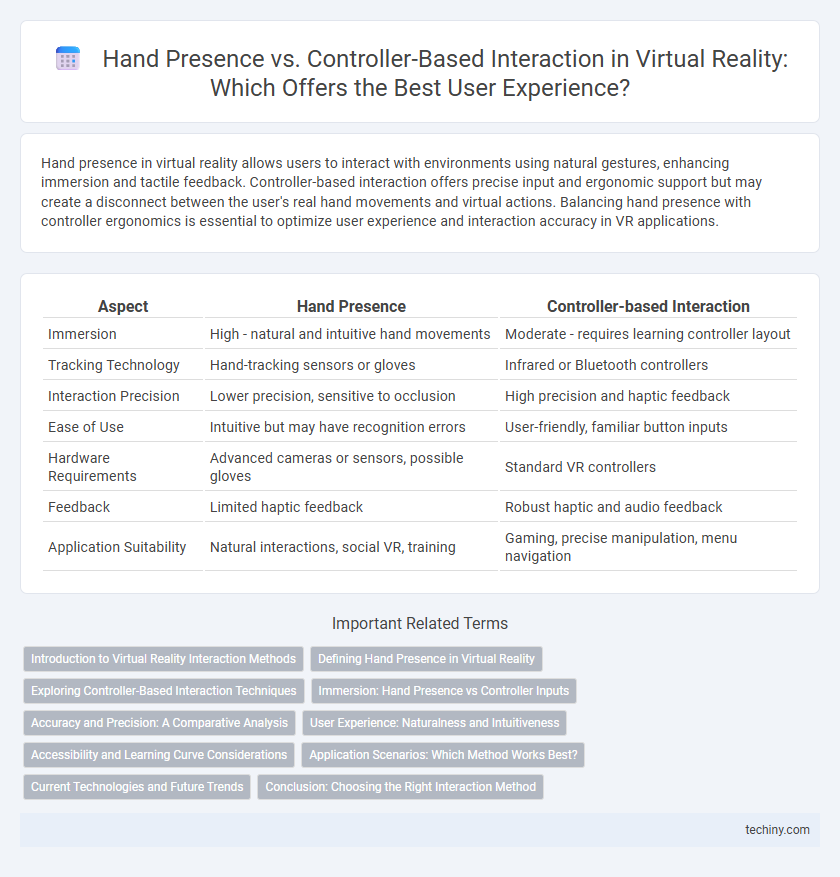Hand presence in virtual reality allows users to interact with environments using natural gestures, enhancing immersion and tactile feedback. Controller-based interaction offers precise input and ergonomic support but may create a disconnect between the user's real hand movements and virtual actions. Balancing hand presence with controller ergonomics is essential to optimize user experience and interaction accuracy in VR applications.
Table of Comparison
| Aspect | Hand Presence | Controller-based Interaction |
|---|---|---|
| Immersion | High - natural and intuitive hand movements | Moderate - requires learning controller layout |
| Tracking Technology | Hand-tracking sensors or gloves | Infrared or Bluetooth controllers |
| Interaction Precision | Lower precision, sensitive to occlusion | High precision and haptic feedback |
| Ease of Use | Intuitive but may have recognition errors | User-friendly, familiar button inputs |
| Hardware Requirements | Advanced cameras or sensors, possible gloves | Standard VR controllers |
| Feedback | Limited haptic feedback | Robust haptic and audio feedback |
| Application Suitability | Natural interactions, social VR, training | Gaming, precise manipulation, menu navigation |
Introduction to Virtual Reality Interaction Methods
Hand presence in virtual reality allows users to interact with digital environments using natural hand movements and gestures, providing intuitive and immersive experiences. Controller-based interaction relies on handheld devices with buttons and sensors to navigate and manipulate virtual objects, offering precision and tactile feedback. Both methods enhance user engagement, but hand presence increasingly drives realism and intuitive control in VR applications.
Defining Hand Presence in Virtual Reality
Hand presence in virtual reality refers to the accurate representation and tracking of a user's hands within a digital environment, enabling natural and intuitive interactions. Unlike controller-based interaction that relies on physical devices, hand presence technology captures real-time finger and palm movements using sensors or cameras, enhancing immersion and reducing the learning curve. This direct manipulation of virtual objects improves user experience by providing tactile feedback and precise control without intermediary hardware.
Exploring Controller-Based Interaction Techniques
Controller-based interaction techniques in virtual reality provide precise and responsive input methods that enhance user engagement through haptic feedback and button mapping. These techniques enable complex gestures, such as grabbing, pointing, and menu navigation, facilitating intuitive control in immersive environments. Advances in ergonomic design and sensor accuracy continuously improve the naturalness and comfort of controller usage, bridging the gap between virtual actions and real-world hand presence.
Immersion: Hand Presence vs Controller Inputs
Hand presence in virtual reality significantly enhances immersion by enabling users to interact naturally with the environment using their own gestures and movements. This intuitive interaction reduces the cognitive gap between the user and the virtual world compared to traditional controller-based inputs, which can limit tactile feedback and precise manipulation. Advanced hand-tracking technologies improve spatial awareness and realism, contributing to a deeper sense of embodiment and presence in VR experiences.
Accuracy and Precision: A Comparative Analysis
Hand presence in virtual reality offers enhanced accuracy and precision by leveraging natural finger movements and tactile feedback, enabling more intuitive interactions compared to controller-based systems. Controller-based interaction relies on external devices with limited degrees of freedom, often resulting in less precise input and reduced spatial awareness. Studies show that hand tracking technologies can improve task performance by up to 30% in fine motor tasks, highlighting their potential to elevate user immersion and interaction fidelity.
User Experience: Naturalness and Intuitiveness
Hand presence in virtual reality significantly enhances user experience by offering natural and intuitive interactions that mimic real-world movements. Unlike controller-based interaction, which relies on button presses and joystick manipulation, hand presence allows for direct manipulation of virtual objects, increasing immersion and reducing cognitive load. Studies show that users report higher satisfaction and faster task completion when using hand presence due to its ergonomic and lifelike interface.
Accessibility and Learning Curve Considerations
Hand presence in virtual reality enhances accessibility by allowing intuitive, natural gestures that reduce barriers for users with limited experience, while controller-based interaction often requires prior familiarity with button layouts and input schemes. The learning curve for hand presence is generally lower, as it mimics real-world hand movements, facilitating quicker adaptation for diverse user groups, including those with motor impairments. Controller-based systems offer precision but may pose challenges for users with limited dexterity, highlighting the importance of tailored interaction models to improve inclusivity and ease of use in VR environments.
Application Scenarios: Which Method Works Best?
Hand presence enhances natural interaction in VR applications requiring fine motor skills, such as surgical simulations or detailed design work, by enabling intuitive gestures and precise object manipulation. Controller-based interaction excels in gaming and training scenarios where tactile feedback and button inputs improve accuracy and user control. Choosing the method depends on the application's need for precision, immersion, and user comfort, with hybrid approaches often delivering the best balance in complex VR environments.
Current Technologies and Future Trends
Current technologies in virtual reality emphasize hand presence through advanced sensors and machine learning algorithms that track finger movements for more natural interaction, contrasted with traditional controller-based systems relying on physical buttons and joysticks. Future trends indicate a shift towards fully sensorless hand tracking and haptic feedback integration, enabling immersive experiences without the need for external devices. Research in neural interfaces and AI-driven gesture recognition promises enhanced precision and reduced latency, driving the evolution of VR interaction beyond current hardware limitations.
Conclusion: Choosing the Right Interaction Method
Hand presence offers natural, intuitive interaction by tracking precise finger movements, enhancing immersion in virtual reality environments. Controller-based interaction provides reliable, tactile feedback and consistent input, essential for complex tasks and gaming precision. Selecting the optimal interaction method depends on the application's goals, user comfort, and the desired balance between realism and control accuracy.
Hand presence vs Controller-based interaction Infographic

 techiny.com
techiny.com